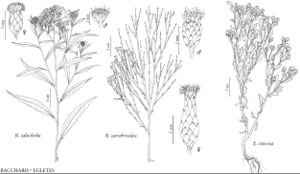Difference between revisions of "Baccharis sarothroides"
Proc. Amer. Acad. Arts 17: 211. 1882.
FNA>Volume Importer |
imported>Volume Importer |
||
| (3 intermediate revisions by 2 users not shown) | |||
| Line 8: | Line 8: | ||
}} | }} | ||
|common_names=Greasewood;rosin-brush;groundsel;desertbroom | |common_names=Greasewood;rosin-brush;groundsel;desertbroom | ||
| + | |special_status={{Treatment/ID/Special_status | ||
| + | |code=F | ||
| + | |label=Illustrated | ||
| + | }} | ||
|basionyms= | |basionyms= | ||
|synonyms= | |synonyms= | ||
| Line 33: | Line 37: | ||
-->{{#Taxon: | -->{{#Taxon: | ||
name=Baccharis sarothroides | name=Baccharis sarothroides | ||
| − | |||
|authority=A. Gray | |authority=A. Gray | ||
|rank=species | |rank=species | ||
| Line 47: | Line 50: | ||
|publication title=Proc. Amer. Acad. Arts | |publication title=Proc. Amer. Acad. Arts | ||
|publication year=1882 | |publication year=1882 | ||
| − | |special status= | + | |special status=Illustrated |
| − | |source xml=https:// | + | |source xml=https://bitbucket.org/aafc-mbb/fna-data-curation/src/2e0870ddd59836b60bcf96646a41e87ea5a5943a/coarse_grained_fna_xml/V19-20-21/V20_28.xml |
|tribe=Asteraceae tribe Astereae | |tribe=Asteraceae tribe Astereae | ||
|genus=Baccharis | |genus=Baccharis | ||
Latest revision as of 20:01, 5 November 2020
Shrubs, 100–400 cm (much branched, broomlike). Stems erect, striate, sharply angled, green distally, glabrous, resinous. Leaves cauline (proximal withered and/or sparse at flowering); sessile; blades (1-nerved) linear-lanceolate, 5–15 × 1–2 mm, reduced to scales distally, thick, bases narrowed, margins entire (often revolute), apices acute, faces glabrous, minutely gland-dotted, resinous. Heads borne singly (on nearly leafless branches) or (laterally on branchlets) in dense paniculiform arrays. Involucres cylindric to hemispheric; staminate 4–5.2 mm, pistillate 3–8 mm. Phyllaries ovate to lanceolate, 1–5 mm, margins yellowish, slightly scarious, medians green to yellow, apices rounded to acute (greenish, abaxial faces glabrous, resinous). Staminate florets 18–35; corollas 4.2–5 mm. Pistillate florets 19–31; corollas 2.5–3.5 mm. Cypselae 2–2.6 mm, finely 8–10-nerved, glabrous; pappi 7–12 mm. 2n = 18.
Phenology: Flowering Aug–Nov.
Habitat: Gravelly and sandy washes, roadsides, railroads, mesquite flats, chaparral
Elevation: 50–1500 m
Distribution

Ariz., Calif., N.Mex., Tex., Mexico (Baja California, Baja California Sur, Sinaloa, Sonora).
Discussion
Baccharis sarothroides is recognized by its broomlike habit, narrow, sharply angular, nearly leafless, green stems, soon-withering proximal leaves, scalelike distal leaves, and heads often terminal on long branches. Specimens from California have smaller heads that sometimes are arranged laterally along the stems.
Selected References
None.
